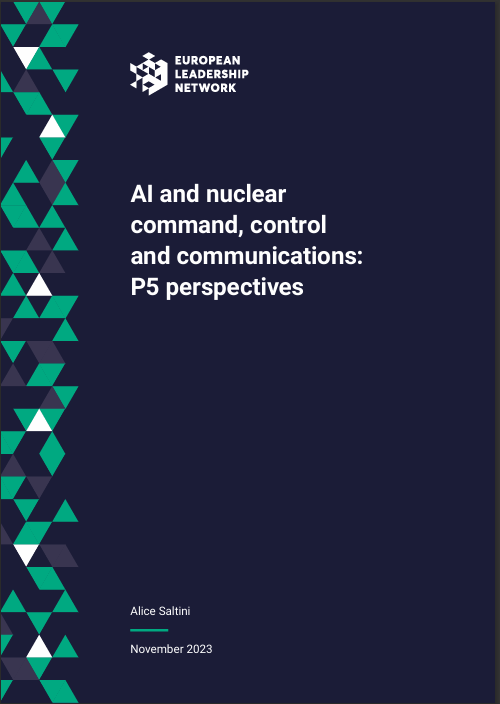Explores the integration of artificial intelligence (AI) into nuclear command, control, and communications (NC3) systems from the perspectives of the P5 states (China, France, Russia, the United Kingdom, and the United States).
Key Findings and Themes
- Technological Reliability and Risks:
- Emphasizes critical issues and risks in integrating AI into NC3 systems, including technological reliability, cyberattack vulnerability, and the importance of aligning with human values and ethics.
- Risk Assessment and Moratorium:
- Alice Saltini, ELN’s Research Coordinator, emphasized the importance of implementing a comprehensive risk assessment strategy. She suggested a moratorium on integrating AI into sensitive NC3 functions until states develop effective frameworks and safeguards to manage these risks responsibly.
- National Perspectives:
- Presents the perspectives of the P5 states on AI integration into nuclear systems:
- United Kingdom: The UK emphasizes the responsible use of AI, focusing on safety, legality, and ethics while recognizing AI’s strategic value.
- China, France, and Russia: Representatives from these countries were cautious about AI integration into critical nuclear decision-making systems. They underscored the consensus on maintaining human control over nuclear decision-making to prevent unintended escalations and ensure strategic stability.
- Presents the perspectives of the P5 states on AI integration into nuclear systems:
- International Dialogue and Cooperation:
- The discussions during the event highlighted the need for international dialogue on the risks posed by AI in nuclear systems. Moreover, the P5 states collectively understood the importance of technological reliability and the necessity of developing international frameworks to manage these risks effectively.
- Strategic and Ethical Considerations:
- Underscores the strategic and ethical considerations of using AI in NC3 systems. It calls for a balanced approach that leverages AI’s potential benefits while mitigating its risks through robust governance and ethical frameworks.
Overview
Research focus and methodology
It analyzed views across P5 states and commissioned bibliographies from China, France, Russia, and the UK to understand their stance on AI in military and nuclear use. Workshops and tabletop exercises were conducted to discuss findings and explore possible escalation scenarios. As a result, the research highlighted the need for a comprehensive risk profiling framework and stakeholder engagement in policy discussions.
The intersection of AI and NC3
Explains the complex interplay between AI and NC3 systems, highlighting the challenges of incorporating deep learning in nuclear decisions. The ELN project investigates the use of AI in NC3 systems by nuclear-armed states and its implications. The discussion underscores varying AI integration due to doctrines, military cultures, and ethics, stressing human oversight. It suggests a risk evaluation framework and norms for implementing AI in nuclear choices.
Understanding the technology
Delves into the technical aspects of artificial intelligence (AI) and its potential applications within nuclear command, control, and communications (NC3) systems. It may discuss different AI techniques, such as machine learning, deep learning, and neural networks, and how these technologies can enhance decision-making processes, data analysis, and situational awareness within NC3 frameworks.
Historical context and current applications
Provides a historical overview of the integration of AI technologies in NC3 systems, tracing the evolution of AI applications in nuclear command and control. It may also explore current real-world examples of AI usage in NC3, highlighting specific technologies or systems implemented by nuclear-weapon states to improve operational efficiency and response times.
Risk and benefit calculus
Assesses the risks and benefits of integrating AI into NC3 systems. It may discuss AI’s potential advantages, such as enhanced decision support, faster data processing, and improved threat detection, as well as its inherent risks, including concerns about reliability, cybersecurity vulnerabilities, and the potential for unintended consequences in nuclear decision-making processes.
Risk determination
Delves deeper into evaluating and determining the risks AI integration poses in NC3 systems. It could explore methodologies for assessing AI-related risks, identifying critical areas of concern, and developing risk mitigation strategies to address potential vulnerabilities and uncertainties associated with AI technologies in nuclear command and control environments.
Views from the expert community
Presents insights and perspectives from AI, nuclear strategy, and international security experts regarding the intersection of AI and NC3. It may include opinions, analyses, and recommendations from scholars, policymakers, and practitioners on the opportunities and challenges posed by AI integration in nuclear decision-making processes and the importance of human oversight and ethical considerations in AI-enhanced NC3 systems.
P5 views on the integration of AI in nuclear decision-making
Explores the perspectives and stances of the P5 nuclear-weapon states (United States, Russia, China, United Kingdom, France) regarding incorporating artificial intelligence (AI) in nuclear decision-making processes. Delves into how these states utilize AI technologies within their nuclear command, control, and communications (NC3) systems and the implications of such integration for strategic stability.
- Diverse Integration Approaches: States exhibit varying approaches to integrating AI into their NC3 systems, reflecting differences in nuclear doctrines, military cultures, civil-military relations, and ethical considerations. Despite these differences, all states recognize the value of AI in enhancing situational awareness, early threat detection, and decision support within their nuclear operations.
- Human Oversight Emphasis: While leveraging AI capabilities, all P5 states emphasize the importance of human oversight in nuclear decision-making processes. The concept of keeping “humans in the loop” is widely supported, although the extent to which this principle is implemented and interpreted may differ among the states.
Areas of Agreement
Highlights the common ground shared by the nuclear-weapon states (United States, Russia, China, United Kingdom, France) regarding the integration of artificial intelligence (AI) in military and defense systems, particularly within the context of nuclear command, control, and communications (NC3).
- Value of AI in ISR Functions and Early Warnings: Nuclear-weapon states recognize AI’s value in intelligence, surveillance, reconnaissance, early warning systems, decision-support systems, and maintaining resilient communication in their NC3 frameworks.
- Risk of Misleading Data: States worry about over-reliance on potentially inaccurate or manipulated AI data. They recognize that insufficient, biased, or corrupted data and cyber-attacks could compromise decision-making in their NC3 systems.
Areas of Disagreement
Delves into the differing perspectives and interpretations among the nuclear-weapon states (United States, Russia, China, United Kingdom, France) regarding integrating artificial intelligence (AI) in nuclear decision-making processes.
- Interpretations of ‘Humans in the Loop’: All P5 states concur that nuclear decision-making should not be fully automated and requires human oversight. However, their interpretations of ‘humans in the loop’- a notion referring to human intervention in AI-assisted processes within nuclear command and control systems- vary.
- Reliance on and Integration of AI in NC3 Structures: The P5 states vary in their use and incorporation of AI in their NC3 architectures. Despite all valuing human judgment in nuclear decisions, the level of AI integration differs due to different approaches, doctrines, and cultural factors.
Recommendations
Presents essential suggestions and measures identified during the European Leadership Network (ELN) project on the intersection of artificial intelligence (AI) and nuclear decision-making. These recommendations aim to mitigate the risks of integrating AI into nuclear command, control, and communications (NC3) systems.
Multilateral approaches
Emphasizes the importance of collaborative efforts among the P5 nuclear-weapon states to address the risks of integrating artificial intelligence (AI) into nuclear command, control, and communications (NC3) systems.
- Transparency and Reporting: States are urged to boost transparency by outlining their AI risk management plans, particularly at NPT meetings. This openness builds trust and illustrates how they handle AI risks in the nuclear sector, especially in decision-making. The subsection underscores the importance of cooperation and transparency in handling AI challenges in NC3 systems. It advocates for proactive measures and information exchange among P5 states to manage AI risks and opportunities in nuclear decision-making.
Bilateral initiatives
Focuses on the importance of bilateral relationships, particularly between the United States and critical nuclear-weapon states like China and Russia, in mitigating the risks associated with integrating artificial intelligence (AI) into nuclear command, control, and communications (NC3) systems.
- Top-Down and Bottom-Up Approaches: Highlights the value of top-down and bottom-up strategies for AI risk management in NC3 systems. It emphasizes the role of intergovernmental discussions in identifying AI risks and expert dialogues in ensuring human oversight and AI reliability in nuclear scenarios.
- Involvement of the Private Sector: Private sector insight into AI risks can improve bilateral AI discussions in NC3 systems, clarifying nuclear implications. The need for joint efforts and stakeholder participation to mitigate AI risks in NC3 systems, given the complexity of AI in nuclear decision-making, is underscored.
Moreover. Nevertheless. Nonetheless. Furthermore. Moreover. Nevertheless. Nonetheless. Furthermore.




